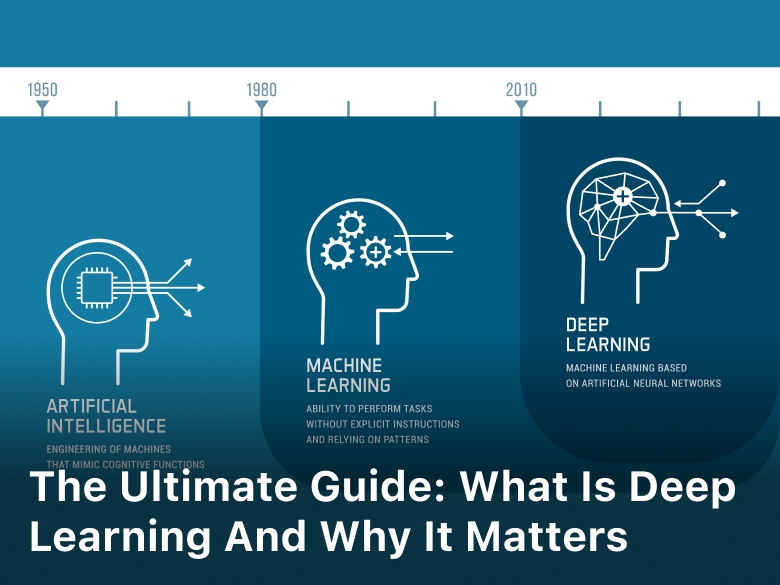
The Ultimate Guide: What Is Deep Learning and Why It Matters
The Ultimate Guide: What Is Deep Learning and Why It Matters – Discover the world of deep learning in this comprehensive guide. Learn what deep learning is, how it works, and its real-world applications. Dive deep into the neural networks that power this revolutionary technology.
In the ever-evolving landscape of artificial intelligence, deep learning stands as a revolutionary concept, driving innovations that have transformed industries and daily life.
This comprehensive guide will take you on a journey through the intricacies of deep learning, helping you grasp the core concepts, applications, and implications of this cutting-edge technology.
What Is Deep Learning
Deep learning is a subfield of artificial intelligence (AI) that simulates the way the human brain works to make computers learn and make decisions on their own.
It’s called “deep” learning because it involves training artificial neural networks, which are made up of interconnected nodes, to process and understand data in a hierarchical and layered manner.
These networks are capable of handling complex and unstructured data, such as images, audio, and natural language, and they excel at tasks like image recognition, natural language processing, and autonomous decision-making. Deep learning has led to remarkable advancements in various fields, from self-driving cars to healthcare, and continues to shape the future of AI.
What is deep learning in simple words?
In simple terms, deep learning is a type of computer technology that helps machines learn and make decisions on their own, somewhat like how humans do.
It does this by using artificial neural networks, which are computer systems that can process and understand information in a way that resembles the human brain.
Deep learning is especially good at handling complex information like pictures, speech, and text, and it’s used in things like recognizing objects in photos, understanding spoken language, and even in self-driving cars. It’s a powerful tool that’s making computers smarter and more capable in a variety of tasks.

What is deep learning vs machine learning?
Deep learning and machine learning are both subfields of artificial intelligence (AI), but they differ in their approaches and capabilities:
Machine Learning (ML)
- Approach: Machine learning uses algorithms to enable computers to learn from and make predictions or decisions based on data. These algorithms are designed to find patterns and relationships in the data.
- Feature Engineering: In machine learning, feature engineering is a crucial step where human experts select and engineer relevant features (characteristics) from the data. These features serve as input to the machine learning model.
- Data Dependency: ML algorithms typically require structured and well-defined data with carefully selected features. They are not well-suited for unstructured data, such as images or raw text.
- Model Complexity: ML models tend to have simpler architectures, and the number of parameters is usually limited. They may not capture complex and hierarchical patterns in data as effectively as deep learning.
- Applications: Machine learning is applied in various domains, including traditional statistical analysis, linear regression, decision trees, and support vector machines. It is effective for tasks such as spam detection, recommendation systems, and credit scoring.
Deep Learning (DL)
- Approach: Deep learning, a subset of machine learning, uses artificial neural networks inspired by the human brain’s structure. It focuses on training deep and complex neural networks to automatically learn and extract features from data.
- Feature Extraction: Deep learning models can automatically extract features from raw and unstructured data, eliminating the need for extensive feature engineering. This is particularly advantageous for tasks like image and speech recognition.
- Data Types: DL is highly effective with unstructured data types, including images, audio, text, and video. It excels in tasks requiring pattern recognition and understanding complex data.
- Model Complexity: Deep learning models, such as deep neural networks, can have many layers and a large number of parameters. This allows them to capture intricate and hierarchical patterns, making them well-suited for complex tasks.
- Applications: Deep learning is used in applications such as image and video recognition, natural language processing (NLP), speech recognition, autonomous vehicles, and playing strategic games like Go and Chess.
In summary, while both machine learning and deep learning are techniques for enabling machines to learn from data, deep learning is a subset of machine learning that specializes in handling complex, unstructured data, often outperforming traditional machine learning methods in tasks like image and speech recognition. The choice between machine learning and deep learning depends on the nature of the data and the complexity of the task at hand.
What is the deep learning process?
The deep learning process involves several key steps:
- Data Collection: The first step is to gather a large amount of data related to the task you want the machine to learn. For example, if you want to teach a machine to recognize cats in images, you’ll need many pictures of cats.
- Data Preprocessing: Raw data often needs to be cleaned and prepared for training. This may involve tasks like resizing images, removing noise, or converting text into a suitable format.
- Building Neural Networks: Deep learning relies on artificial neural networks, which are structures composed of interconnected nodes. These networks are designed to mimic the human brain’s ability to process information. Creating the right network architecture is crucial, including deciding how many layers and nodes it should have.
- Training the Model: This is where the learning happens. The neural network is exposed to the prepared data, and it adjusts its internal parameters through a process called backpropagation. The goal is to minimize the difference between the model’s predictions and the actual data.
- Validation and Testing: After training, the model needs to be tested on new, unseen data to ensure it generalizes well. Validation data helps fine-tune the model’s hyperparameters, like learning rate, to improve its performance.
- Optimization: The model may need further adjustments and optimization to enhance its accuracy and efficiency. This might involve experimenting with different algorithms or network architectures.
- Deployment: Once the model is trained and optimized, it can be deployed for practical use. For example, a trained deep learning model for image recognition could be used in a mobile app or integrated into a larger system.
- Continuous Learning: Deep learning models can benefit from ongoing learning. As more data becomes available, the model can be periodically retrained to stay up-to-date and maintain its accuracy.
The process of deep learning can be iterative, with multiple cycles of training, testing, and refinement to achieve the desired level of performance. It’s a complex but powerful approach that has been used in a wide range of applications, from natural language processing to autonomous vehicles.
Real-World Applications
Healthcare
Deep learning is revolutionizing healthcare by enhancing disease diagnosis, drug discovery, and personalized treatment plans. Radiologists are using deep learning algorithms to analyze medical images, improving the accuracy of diagnoses.
Autonomous Vehicles
Self-driving cars rely on deep learning to make split-second decisions. Deep neural networks process data from sensors, enabling vehicles to navigate safely and efficiently.
Natural Language Processing (NLP)
Voice assistants like Siri and language translation apps like Google Translate use deep learning to understand and respond to human language. It’s transforming the way we communicate across languages.
Why is deep learning so effective?
Deep learning is highly effective for several reasons:
- Complex Data Handling: Deep learning excels at processing and understanding complex, unstructured data such as images, audio, and text. It can automatically extract relevant features from this type of data, which is challenging for traditional machine learning methods.
- Hierarchical Learning: Deep learning models, particularly deep neural networks, use a hierarchical approach to learning. They consist of multiple layers of interconnected nodes, allowing them to learn intricate patterns and representations of data at different levels of abstraction.
- Feature Extraction: Deep learning models can learn to automatically extract meaningful features from raw data. This eliminates the need for manual feature engineering, where human experts would define relevant characteristics of the data.
- Scalability: Deep learning models can scale with the amount of data available. More data often leads to better performance, making deep learning suitable for tasks that require large datasets, such as image recognition and natural language processing.
- Versatility: Deep learning models are versatile and can be applied to a wide range of tasks, from image classification to speech recognition to language translation. This adaptability has led to their widespread use across various industries.
- Continuous Improvement: Deep learning models can continue to improve with more data and fine-tuning. This adaptability allows them to stay relevant and accurate in rapidly changing environments.
- Parallel Processing: Deep learning algorithms are designed to take advantage of modern hardware with multiple processing units (GPUs and TPUs). This parallel processing capability speeds up training and inference, making deep learning practical for real-time applications.
- Transfer Learning: Deep learning models can be pre-trained on large datasets and then fine-tuned for specific tasks. This transfer learning approach saves time and resources, as models can leverage knowledge gained from one task to perform well in related tasks.
- Highly Non-linear Models: Deep neural networks are inherently non-linear models, capable of capturing intricate relationships in data. This non-linearity enables them to model complex functions accurately.
- Continuous Research: The field of deep learning is dynamic, with ongoing research leading to the development of new architectures, techniques, and algorithms. This constant innovation ensures that deep learning methods remain at the cutting edge of AI technology.
In summary, deep learning’s effectiveness lies in its ability to handle complex data, automatically extract features, adapt to different tasks, and continually improve with more data and research advancements. These qualities have made deep learning a transformative technology across various domains.
FAQs
Q: How does deep learning differ from traditional machine learning?
A: Deep learning uses neural networks to automatically learn patterns, while traditional machine learning requires manual feature engineering.
Q: Can deep learning be applied to small businesses?
A: Yes, deep learning can benefit businesses of all sizes by improving processes, customer experiences, and decision-making.
Q: Is deep learning only for tech companies?
A: No, deep learning has applications across various industries, from healthcare to finance and agriculture.
Q: Are there any ethical concerns with deep learning?
A: Yes, ethical considerations include data privacy, bias in algorithms, and job displacement due to automation.
Q: How can one get started with deep learning?
A: Start by learning Python, understanding neural networks, and exploring online courses and resources.
Q: What are the challenges of implementing deep learning in businesses?
A: Challenges include data quality, infrastructure requirements, and the need for specialized expertise.
Conclusion
In conclusion, deep learning is not just a buzzword; it’s a transformative technology shaping our future. Its impact on healthcare, autonomous vehicles, AI, and countless other fields cannot be overstated.
Embracing deep learning is not an option but a necessity for staying relevant and competitive in the rapidly evolving landscape of technology. So, dive deep into the world of deep learning and unlock the endless possibilities it offers.





